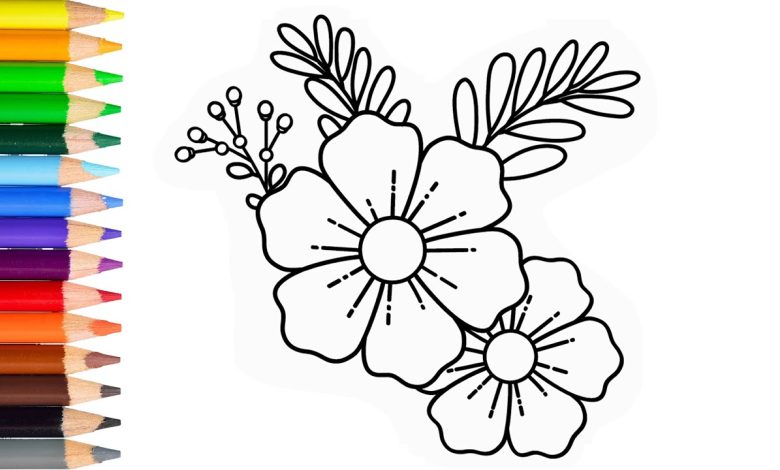Creative Flowers Drawing: From Sketch to Stunning Artwork

Drawing flowers is a timeless art form that has captivated artists for centuries. Whether you’re a seasoned artist or a beginner, the simplicity and beauty of flowers offer endless opportunities for creativity. This guide will take you through the process of transforming a simple sketch into a stunning piece of floral artwork. By the end, you’ll be able to create your own masterpiece that not only showcases your artistic skills but also celebrates the natural beauty of flowers.
Understanding the Basics of Flowers Drawing
Before diving into the creative process, it’s important to understand the basics of flowers drawing. Flowers, with their intricate details and delicate petals, can seem daunting to draw at first. However, by breaking down the structure of a flower into simple shapes, you can create an accurate and aesthetically pleasing drawing.
Start by observing the flower you wish to draw. Notice its basic shapes—many flowers have a circular or oval shape at the center, with petals radiating outward. Stems and leaves often follow a more linear pattern. By focusing on these simple shapes, you can create a strong foundation for your drawing.
Materials Needed for Easy Flowers Drawing
To get started with your flowers drawing, you’ll need a few basic materials:
- Sketching pencils: A range of pencils (2H, HB, 2B, 4B) allows for various line strengths and shading techniques.
- Eraser: A soft eraser for gentle corrections and a kneaded eraser for highlights.
- Paper: High-quality drawing paper or sketchbook paper.
- Optional: Colored pencils, markers, or watercolors for adding color.
Step 1: Sketching the Outline
Begin your drawing of flowers by lightly sketching the basic outline. Start with the center of the flower, which is often a simple circle or oval. From there, sketch the general shape of the petals, keeping the lines light and loose. Don’t worry about making it perfect at this stage—this is just the foundation for your final artwork.
For beginners, it’s helpful to use reference images of flowers. Look for pictures that clearly show the flower’s shape and structure. As you sketch, focus on capturing the overall form of the flower, rather than getting bogged down in the details.
Step 2: Refining the Drawing
Once you have the basic outline, start refining your drawing of flowers by adding more details. This is where you begin to define the shape of the petals, stems, and leaves more clearly. Pay attention to the edges of the petals—are they smooth or ruffled? Do they overlap, or are they spaced apart?
As you refine your drawing, use a darker pencil (such as a 2B) to emphasize the lines that you want to keep, while gradually erasing the lighter sketch lines. Take your time with this step, as the accuracy of your details will greatly impact the final look of your flowers drawing.
Step 3: Shading and Adding Depth
Shading is crucial for bringing your flowers drawing to life. It adds depth and dimension, making your flower appear more realistic and three-dimensional. Start by identifying the light source in your drawing—this will determine where the shadows and highlights fall on your flower.
Using a range of pencils (from HB to 4B), begin shading the areas of the flower that are in shadow. Apply light pressure for subtle shading and increase the pressure for darker areas. Use a blending stump or your finger to smooth out the shading and create a soft gradient.
Don’t forget to add shading to the stems and leaves as well. This will help anchor the flower in your drawing and make it feel more cohesive. The contrast between the light and dark areas will make your drawing of flowers stand out and give it a professional finish.
Step 4: Adding Color (Optional)
If you want to take your flowers drawing to the next level, consider adding color. While a black-and-white drawing can be beautiful on its own, color can enhance the visual appeal and make your artwork pop.
You can use colored pencils, markers, or watercolors to add color to your drawing. Start with the lightest colors first, gradually building up to the darker shades. Pay attention to the natural colors of the flower you’re drawing—try to replicate these as closely as possible for a realistic effect.
When adding color, it’s important to maintain the shading and highlights that you established earlier. This will ensure that your flower retains its depth and dimension, even with the added color.
Step 5: Final Touches and Highlights
The final step in your flowers drawing is to add the finishing touches. This includes adding any final details, highlights, and adjustments to ensure that your artwork looks polished and complete.
One technique for adding highlights is to use a kneaded eraser to lift some of the graphite from the paper. This is particularly effective for creating the appearance of light reflecting off the petals or leaves. You can also use a white colored pencil or gel pen to add small highlights and enhance the contrast in your drawing.
Take a step back and view your drawing from a distance. This will help you see if there are any areas that need more attention or if the overall composition is balanced. Make any necessary adjustments, and your flowers drawing is complete!
Tips for Creative Flowers Drawing
- Practice regularly: Like any skill, drawing improves with practice. Set aside time each day to work on your flowers drawing, even if it’s just for a few minutes.
- Experiment with different styles: Don’t be afraid to try different styles and techniques in your drawings. Whether you prefer realistic, abstract, or cartoonish flowers, experimenting will help you develop your unique style.
- Use reference images: Reference images are invaluable for learning how to accurately depict flowers. They can help you understand the structure, proportions, and details of different flower species.
- Be patient: Flowers drawing requires patience and attention to detail. Take your time with each step and don’t rush the process.
Common Mistakes to Avoid in Flowers Drawing
- Overworking the drawing: One of the most common mistakes is overworking your drawing. If you’re not careful, you can end up with smudges, overly dark lines, and a loss of detail. Try to keep your lines light and deliberate.
- Ignoring proportions: The proportions of a easy:3vz4qc7cf5i= flowers drawing are crucial to achieving a realistic look. Pay close attention to the size and placement of each element in your drawing.
- Neglecting the background: While the flower is the focal point of your drawing, don’t forget about the background. A simple background can enhance your flowers drawing and make it feel more complete.
Conclusion
Creating a stunning flowers drawing from a simple sketch is a rewarding process that allows you to express your creativity and improve your artistic skills. By following the steps outlined in this guide, you can develop a beautiful and realistic drawing of flowers that captures the essence of these natural wonders. Remember to practice regularly, experiment with different techniques, and most importantly, enjoy the process. With patience and persistence, you’ll be able to create floral artwork that you’re proud to showcase.




